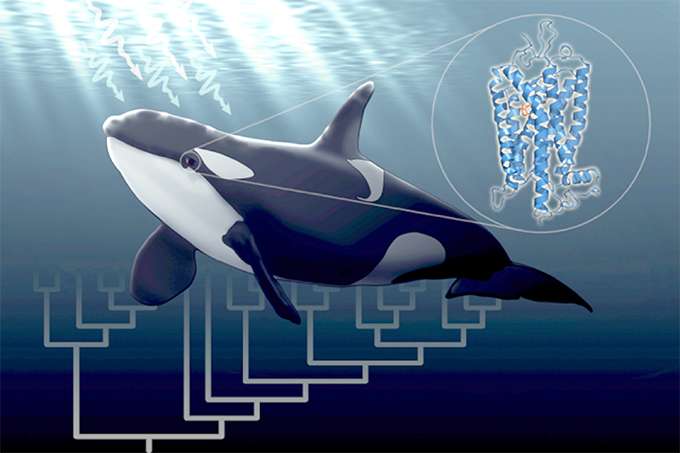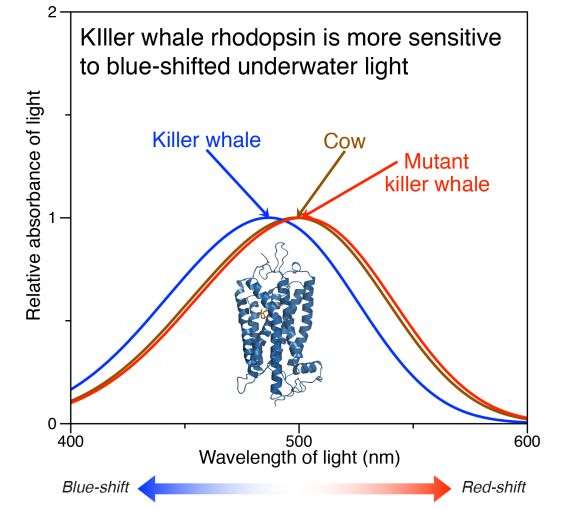Shedding light on the evolution of whale vision

Eyes are the window between an animal and its environment, and if your environment has changed as much as a whale's has over the last 50 million years, they tell an intriguing story about your evolutionary history. As marine mammals that descended from terrestrial ancestors, whales and dolphins have many adaptations for aquatic living, including underwater vision, but we still know very little about how these adaptations evolved at the genetic level.
Researchers from the Department of Ecology and Evolutionary Biology at the University of Toronto used a combination of statistical and experimental methods to determine how the gene coding for the visual protein known as rhodopsin has evolved differently in whales and dolphins relative to terrestrial mammals. By using killer whale rhodopsin as an experimental model, their results show that not only is the rhodopsin gene under natural selection pressure in whales, but also that naturally selected mutations in the gene confer greater sensitivity towards blue-shifted underwater light. This makes it one of the first whale evolution studies to directly link selection patterns with a measurable change in function.
Their findings were published ahead of print as an Advance Access publication on October 20, 2015 in the science journal, Molecular Biology and Evolution, and presented at the recent biennial meeting of the Society for Marine Mammalogy in San Francisco on December 17, 2015. Funding was provided by the Natural Sciences and Engineering Research Council of Canada (NSERC).
Sarah Dungan, PhD candidate and lead author of the paper elaborates: "Rhodopsin is a light-sensitive protein in the rod cells of your eyes that allows you to see even in dark conditions. Whales are particularly relianton rhodopsin because light fades very quickly with depth underwater. But the majority of light in the ocean is also blue, so if you're a deep diver like a sperm whale, having rhodopsin more sensitive in the blue part of the spectrum allows your eyes to make the most use of the scarce light hundreds of meters below the surface. This could mean the difference between catching your prey or going hungry."
Even in species that hunt closer to the surface, such as the killer whale, rhodopsin sensitivity is blue-shifted compared to close terrestrial relatives like the cow.

These functional aspects of protein evolution are often overlooked when selection signatures in genes or genomes are over-emphasized. "Bioinformatics and evolutionary statistics are hot areas of research now," according to Dungan, "but to say anything about adaptation you need to also show how genetic changes may be of benefit to the organism, and that often requires an interdisciplinary approach."
"Visual proteins like rhodopsin are ideal for this kind of research because their functional response to light can be directly measured in vitro," adds Dr. Belinda Chang, an expert in the biology of vision and visual protein biochemistry, and leader of the lab behind the study. "The computational methods tell us where to focus our efforts. Which parts of the gene's DNA sequence has natural selection been changing? Which structural areas of the rhodopsin protein do these correspond to? But the mutation experiments show us what those evolutionary changes actually do to the protein's function – that they shift rhodopsin's sensitivity to different parts of the light spectrum."
The study's results, published in Molecular Biology and Evolution, show computational and experimental evidence of natural selection in whale rhodopsin for vision in underwater environments, illuminating one facet of how these remarkable creatures have adapted to life in the sea.
More information: Sarah Z. Dungan et al. Spectral Tuning of Killer Whale ( ) Rhodopsin: Evidence for Positive Selection and Functional Adaptation in a Cetacean Visual Pigment , Molecular Biology and Evolution (2016). DOI: 10.1093/molbev/msv217
Journal information: Molecular Biology and Evolution
Provided by University of Toronto



















